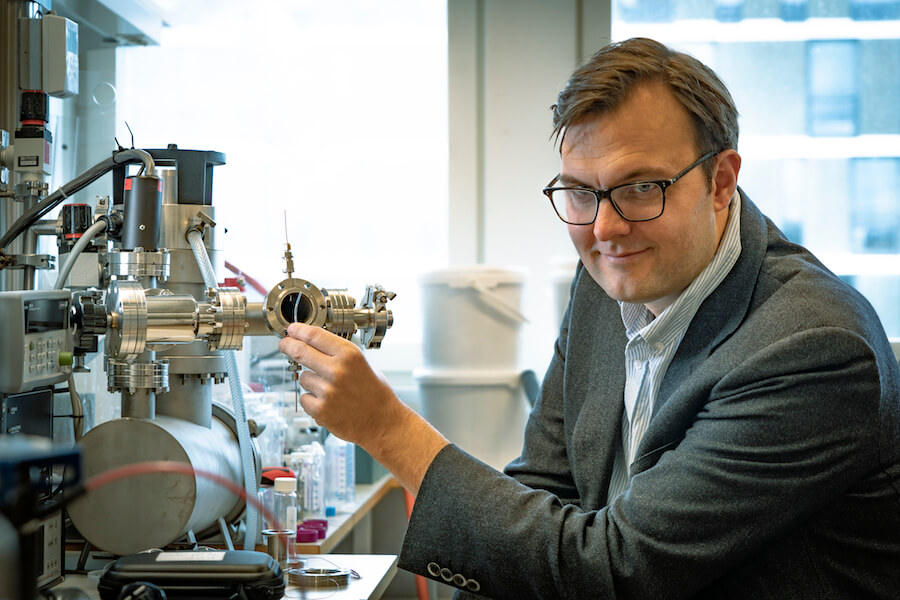The future of solar energy may not look the way you might expect.
As solar panel and battery technologies grow more and more sophisticated, making it possible to dream of a day where we live off the sun’s energy, scientists at Chalmers University, Sweden, are developing a bold new solar technology — a chemical liquid capable of harnessing energy from the sun and storing that energy for future use.
Through the novel approach, solar energy is captured in the molecular bonds of a unique chemical fluid. The energy can then be released from the chemical through the introduction of a catalyst and put to use.
The research team has named the system Molecular Solar Thermal Energy Storage (MOST).
The system is not yet complete, but the research team, led by Kasper Moth-Poulsen, a professor of chemistry at Chalmers, has made critical strides.

The project was initiated several years ago, when Moth-Poulsen moved to Chalmers from the University of California, Berkeley. As a postdoctoral researcher at Berkeley, Moth-Poulsen had worked on a system for harnessing solar energy using ruthenium, a rare transition metal.
When he moved to Chalmers in 2011, he continued working on molecular solar thermal energy storage, but began exploring the use of carbon-based elements, which are cheaper and more common than ruthenium.
About a year ago, the research team developed a new molecule made from carbon, hydrogen and nitrogen, which is capable of storing chemical energy.
When sunlight hits the molecule, it absorbs the heat and transitions into an energy-rich isomer, a molecule with the same chemical formula, but in a new arrangement. The sunlight breaks double bonds in the molecule and forms new single bonds that store the solar energy.
The energy can then be released by introducing a chemical catalyst that effectively reverses the process.
The catalyst is arranged as a filter that the liquid can flow through. When liquid passes through the catalyst, it creates a reaction that releases the energy, increasing the liquid temperature by 63 degrees celsius. The process reverts the molecule to its original form, so it can be reused.
The team has released four new articles detailing advancements so far in 2018.
- A solvent-free system that increases the energy density, or the amount of energy stored per kilogram of the chemical liquid, to over 0.4 MJ/kg;
- A new molecular design that enables storage for up to 18 years;
- A way to increase the energy storage density to 0.9 MJ/kg; and
- The practical demonstration of a temperature gradient in the system of up to 63 degrees Celsius.
Altogether, these developments represent a significant step forward. The system is no longer reliant on toluene, a flammable chemical that the team had previously used as part of the chemical liquid.
Since the researchers removed toluene from the process, the system only requires the energy-trapping molecule and the catalyst.
“We have made many crucial advances recently, and today we have an emissions-free energy system which works all year round,” Moth-Poulsen said in a statement.
There is still a long way to go, however. Moth-Poulsen said he did not know when to expect MOST to be fully developed or ready for commercial or industrial use.
“This depends a lot on the type of funding we can attract and what industrial partners we might find,” he said. “It is our vision to develop the MOST technology from a university research project into real life technologies. For this we are currently looking for the right type of partners that can make this happen together with us.”
Currently, the researchers are working on developing scalable and green chemistry methods to enable large-scale production. They are also seeking ways to improve the efficiency of the solar energy capture. They would also like to reach a temperature increase of at least 110 degrees Celsius, Moth-Poulsen said.
So there’s a way to go, but once it is fully realized, MOST could change the future of solar energy.
It is easy to envision the system used to heat homes by passing the heated liquid through radiators throughout a house. Used in combination with more traditional solar panels and batteries, the technology could help us utilize tremendous amounts of renewable energy from the sun and ultimately transition away from greenhouse gases.



